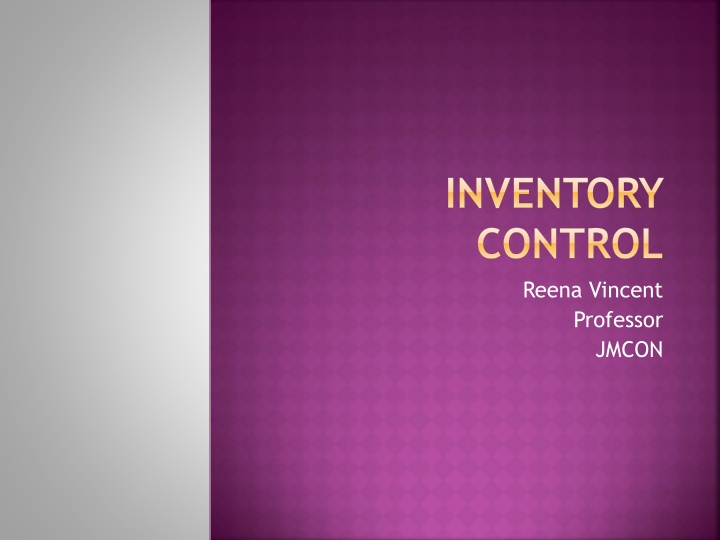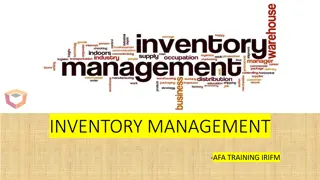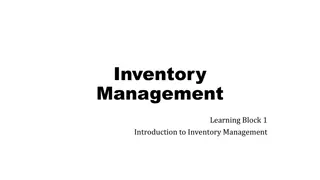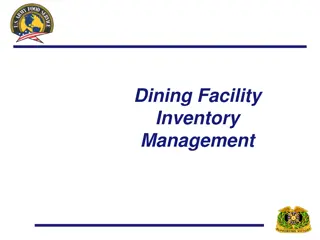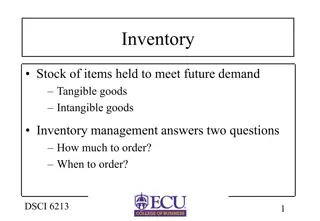Comprehensive Guide to Inventory Control in Nursing Education
Explore the fundamentals of inventory control in nursing education, covering topics such as defining inventory, objectives of inventory control, importance, techniques, and accounting systems. Learn how inventory control plays a vital role in ensuring efficient and effective nursing service delivery. Discover the central and specific objectives, along with the key principles and benefits associated with managing inventory effectively to meet the demands of healthcare operations.
Download Presentation

Please find below an Image/Link to download the presentation.
The content on the website is provided AS IS for your information and personal use only. It may not be sold, licensed, or shared on other websites without obtaining consent from the author.If you encounter any issues during the download, it is possible that the publisher has removed the file from their server.
You are allowed to download the files provided on this website for personal or commercial use, subject to the condition that they are used lawfully. All files are the property of their respective owners.
The content on the website is provided AS IS for your information and personal use only. It may not be sold, licensed, or shared on other websites without obtaining consent from the author.
E N D
Presentation Transcript
INVENTORY CONTROL Reena Vincent Professor JMCON
CENTRAL OBJECTIVE At the end of teaching students acquire depth knowledge on inventory control and able to explain and apply this knowledge in the nursing service and education .
SPECIFIC OBJECTIVES At the end of the class student will be able to Define inventory, inventory control List the objectives of inventory control Identify the importance of inventory control Explain maintaining inventory control and inventory standards Describe the various techniques of inventory control. Describe the inventory accounting system
INTRODUCTION The inventory is a stock to ensure uninterrupted suppliers and to have future economic value . It provides a cushion between the estimated and actual demand for materials. Inventory is anything that is bought and held prior to use
Inventory means all the materials, parts, supplies, expenses and in processes or finished products recorded on registers books by an organization and kept in its stocks for some period of time.
INVENTORY CONTROL Inventory control is the process by which inventory is measured and regulated according to predetermined norms such as economic lot size for order, safety stock, and minimum level, Maximum level, order level etc.
OBJECTIVES OF INVENTORY CONTROL To supply the materials in time . To give maximum clients service by meeting their requirement timely, effectively, efficiently, smoothly and satisfactorily. To reduce or minimize investment in inventories .
CONTD.... To minimize idle time by avoiding stock out and storages . To avoid shortage of stock . To minimize the losses due to deterioration, obsolescence and damage of stock. To meet unforeseen future demand . To average out demand fluctuations . To balance various inventory costs such as carrying cost, order costs etc.
IMPORTANCE OF INVENTORY CONTROL It provides and maintains good customer s service. Enables smooth flow of materials through production process. Provides protection against the uncertainty of demand and supply. Ensures a reasonable utilization of equipment and effort . Possibility of discount, if purchased in bulk.
To provide gap between forecasted and actual demand for a material. To have optimum level of inventory; not too large, not small. To eliminate duplication in ordering
To take care of fluctuations in demand and lead time and price in bulk buying To minimizes the transportation cost, inventory costs and waiting time . It monitors the loss of material and utilization of stocks available . To facilitate the cost accounting activities and disposes inactive and obsolete store items .
MAINTAINING INVENTORY CONTROL MAJOR ACTIVITIES OF INVENTORY CONTROL ARE Planning Procurement Receiving and inspection Storing and issuing the inventories recording the receipt and issuing of inventories Physical verification Follow up functions Material standardization and substitution of materials and also the activities of inventory control.
STANDARDS IN INVENTORY CONTROL/INVENTORY STOCK LEVELS There are four important standards(levels are fixed ) in inventory control. The minimum level The maximum level Reorder level Reserve stock
1 MINIMUM LEVEL Is the level below which the available supplies should never drop. Minimum level is determined by the rate at which an item is used, its importance and its normal procurement time .
CONT... Minimum level is the minimum stock to be maintained for smooth production. Never set as zero . Minimum level =reorder level average usage per period x average time to obtain delivery
2 MAXIMUM ORDER LEVEL Is when the system is working properly. It is the level of stock beyond which the stock is not maintained .
CONTD If the inventory is maintained beyond this point, there would be loss to the hospital by way of expiry of life items beyond the shelf life of items, loss incurred on the capital locked up in the inventory, unnecessary use of items just to exhaust the inventory.
3 AVERAGE STOCK LEVELS The average stock levels is half of the maximum and minimum stock level. Maximum level+ Minimum level 2
4. RESERVE STOCK Excess usage requirement during normal lead time
5 RE-ORDER LEVEL: it is the stock level at which an order should be placed Reorder level = maximum reorder period x maximum usage Average stock level = maximumlevel+minimum level 2
INVENTORY CONTROL TECHNIQUES,ITS BASIS AND USES Technique ABC Analysis (Always better control ) Basis value of consumption Main uses To control inventories VED Analysis (Vital,Essential,Desir able ) criticality of items To determine the stocking levels consumption pattern of items To control obsolescence FSN Analysis (fast, slow moving and non- moving ) SDE Analysis (Scarce,difficult,easy ) problem faced in procurement Lead time analysis and purchasing strategies
Technique Basis Main uses HML Analysis (High,Medium,Low) unit price of material To control purchasing XYN value of items in storage To review the inventory and their uses at scheduled intervals GOLF sources of material procurement from different sources SOS Nature of supplies procurement /holding strategies for seasonal items .
ABC ANALYSIS(PARETO ANALYSIS) DEFINITION It is the analysis of stores items on cost criteria. It is a very common tool.
A items- Represents high cost centre B items- intermediate cost centre C items- low cost centre. It is the process of classifying items by using values as measure.
ABC Class A Class B Class C CLASSIFICATION LEVELS Items Number of items 10 20 70 as a % of total number Annual usage 70 20 10 value as a % on total usage value
Class A: High value items, consume major portion of the funds. Small in number, managed by top management.
A items must have 1. Rigorous value analysis . 2. Rigid estimates of requirement . 3. Strict and close watch. 4. Require low safety stocks 5. Centralized purchasing and storage.
Class B items -Medium value items 1. Moderate controls 2.Purchase based on rigid requirement 3.Reasonably strict watch and control 4. Management be done at middle level
Class C: Low values items, but are required in large quantities and consists of various types and varieties like clips, washers.
C items 1. Ordinarily control measures . 2. Purchased based on usage estimates . 3. Controls exercises by store keeper. 4. Management be done at lower levels. 5.Decentralized (delegated) purchasing.
PRINCIPLES OF ABC ANALYSIS The analysis is depends on its annual 1. consumption values rather than unit cost. The limits for ABC categorization are not 2. uniform but depend on the size of organization, its inventory as well as number of items controlled.
CONTD The analysis does not depend on the 3 importance of items rather based on material credibility and available status of material, material physical characteristics and frequency of material usage. 4 It also depends on degree and 4 characteristics of control to be exercised by the management
METHOD OF ABC ANALYSIS Gather all the inventory data and make a list of the store items with the unit price/ item and yearly consumption. Calculate annual usage Arrange items in the descending order according to the total value of consumption (annually )per piece in rupees . Assign item numbers against their annual usage Find out cumulative annual usage / consumption cost and in percentage Classify items according to their percentage consumption value(price ). 1. 2. 3. 4. 5. 6.
ADVANTAGES OF ABC ANALYSIS Investment in inventory can be maintained. Easy to control the wastage of costly items. Helps in maintaining the safety to the cost. Easy to maintain stock and turnover rate. Helps to exercise selective control when confronted with large number of items.
Rationalize the number of orders, number of items and thus reduces the inventory. Shows visible results in a short span of time. The manager is able to control the inventories specially controlling the A it helps to pin point the obsolete stocks. Helps in reducing administrative cost.
DISADVANTAGES Proper standardization and codification of inventory items is required. Consider only the money value not the importance of items for functioning. It is challenging to have periodic reviews on ABC analysis .
APPLICABILITY It has universal application for fields requiring selective control. It can be used in any setting to control the cost. it extends almost all aspects of material Management such as purchasing receiving and inspection
VED ANALYSIS Based on the criticability of the items . In VED Method (vital, essential and desirable) , each stock item is classified on either vital, essential or desirable based on how critical the item is for providing health services.
Vital Items without which treatment comes to standstill: i.e. non- availability cannot be tolerated. The vital items are stocked in abundance, eg.oxygen supply. Essential Items without which an institution cannot function but may affect the quality of services. E.g. Antibiotics, I.V Fluids.
Desirable: Items whose non availability can be tolerated for a long period. Which will not interfere the with functioning because they can be easily purchased as a and when required. on an average vital items are 10%, essential items are 40% and desirable items make 50% of total items available.
ADVANTAGES OF VED ANALYSIS It is useful for monitoring and control of stores and spares inventory. Determine the criticality of items and its effect on production and other services. It is useful in controlling and maintaining the stock of various types. It classifies spare parts or objects based on the necessity of things.
MATRIX OF ABC/ VED ANALYSIS Combination of these two categories like a matrix combining ABC and VED categories. These items can be controlled by the top- level management.
The CD category items are not very costly and at same time of desirable category. These items can be controlled at the lower level.
MATRIX OF ABC/ VED ANALYSIS This matrix is more relevant in the hospitals Category 1 Category 11 Category 111 V E D A AV AE AD B BV BE BD C CV CE CD
CONTROL OF VED ITEMS a. Category I items: these items are the most important ones and require control by the administrator himself. b. Category II items: these items are of intermediate importance and should be under control of the officer in charge of the stores. c. Category III items: these items are of least importance which can be left under the control of the store keeper.
ADVANTAGES it aids in management in materializing the policy and service standard. To control the stock levels by visualizing the inventory carrying cost.
FSN ANALYSIS Meaning is fast moving, slow moving and non- moving classification is based on consumption pattern of the items or design of issue of items from stores. METHOD DATE The items are usually grouped in periods of 12 months . Non moving items must be periodically reviewed to prevent expiry
ANALYSIS For analysis the issuing of items in past two or three years are considered. If there is no issuing of items during that period it is labelled N item. 10-15 issues in that period the item is S item. The item exceeding such limits of numbers of issues during that period is F item.
